Brief
It’s been a long time coming, but most economies are emerging from the global downturn—and growing. Executives who slogged through years of recession or stagnation are feeling more confident, even exuberant— perhaps too exuberant. Many also see disruptions and challenges ahead. Forces such as the demographics of emerging economies, aging populations and resource scarcity are accelerating deep structural shifts in global markets. And although these forces generate opportunities for growth, they also unleash risks. Digital technologies, for example, give rise to new markets, but they also bring volatility, macroeconomic shocks and disruption: Think cyber attacks, which are now a hazard for all companies as digital connectivity becomes the norm. As executives grapple with a landscape increasingly dominated by technology and change, they plan to spend more on innovation, IT and long-term growth capabilities, and they are embracing digital transformation tools.
Overall, Bain & Company’s 15th Management Tools & Trends survey showed executives confident and upbeat— 74% said their current financial performance is strong, and 55% believe economic conditions are improving in their industry (see Figure 1), with pharma and biotech, construction and real estate, and financial services being the most optimistic sectors. Despite the challenges ahead, 75% of respondents feel better positioned for the future, saying their ability to adapt to change is a significant competitive advantage—the same number as in the 2013 survey (see Figure 2). In China and India, where the outlook for growth is strongest, confidence in the ability to adapt to change was even higher at 88%.
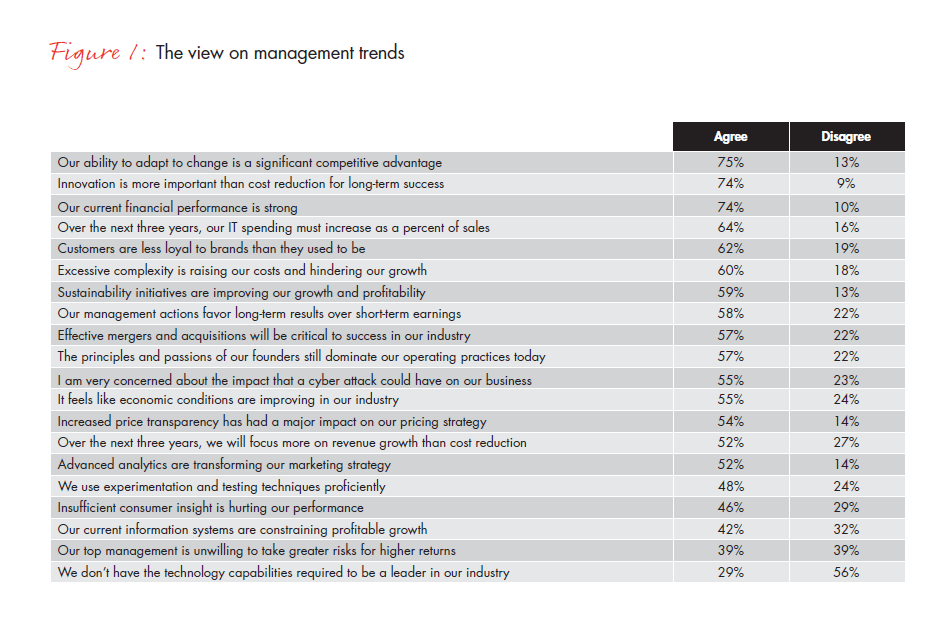
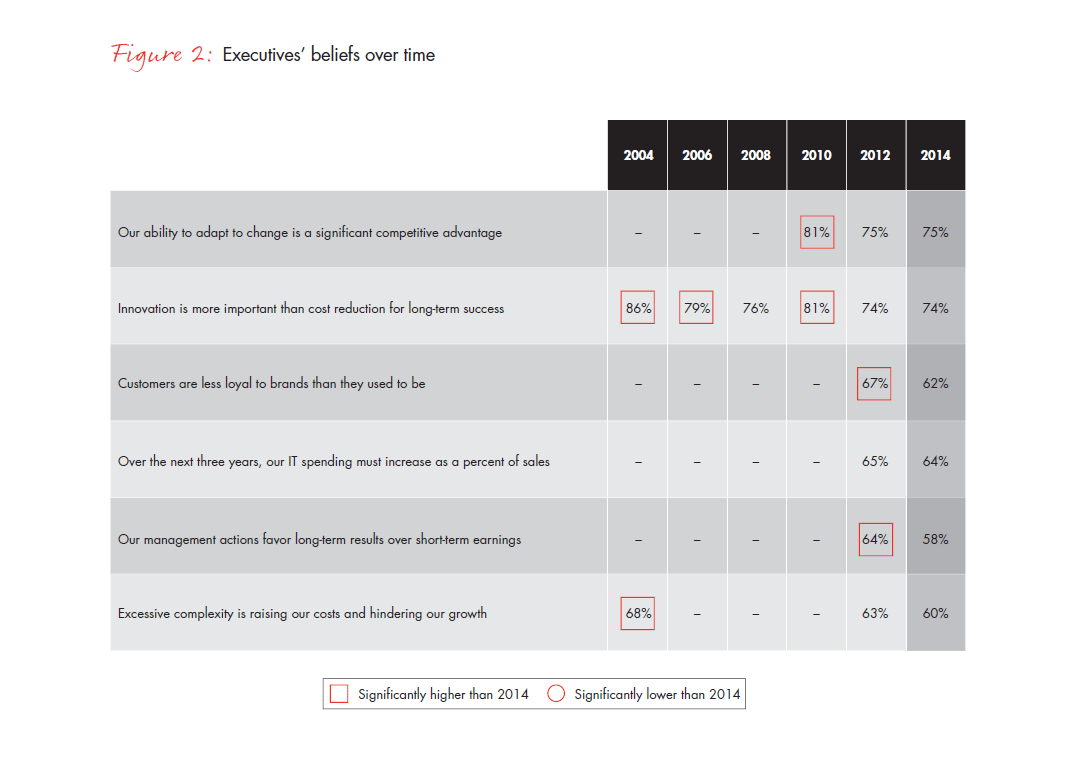
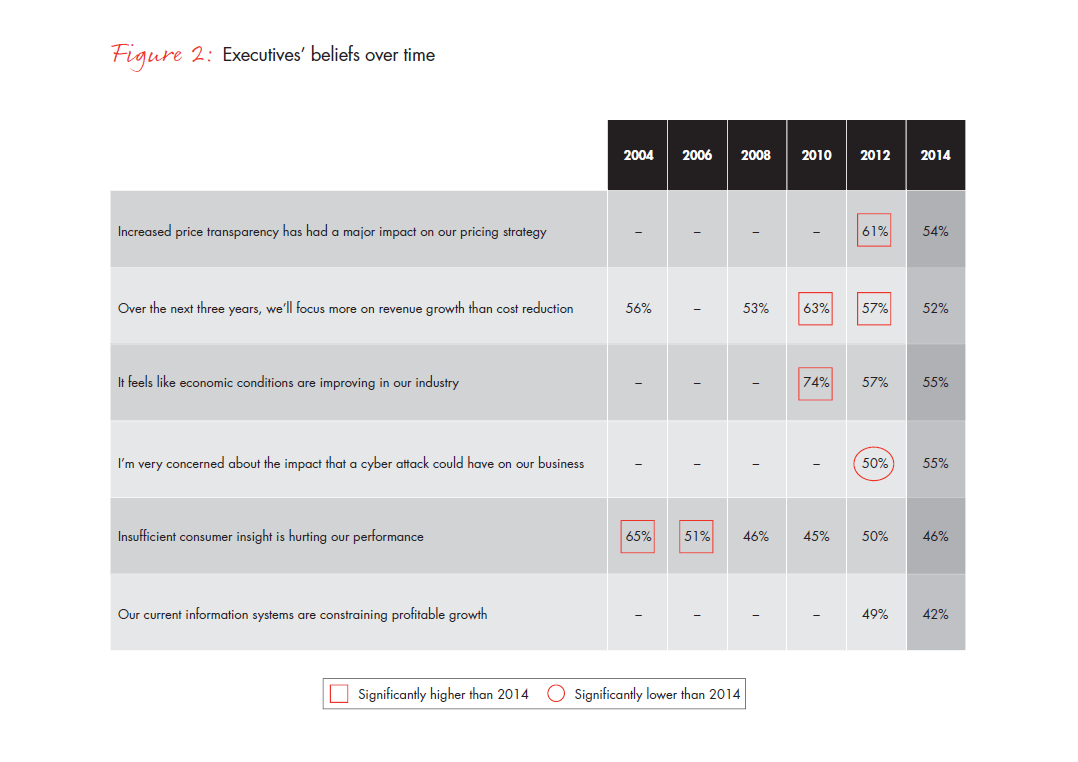
Can three out of four firms really be poised to outperform? Clearly, many companies have worked hard to cut costs and improve efficiency throughout the downturn, but we see a significant risk in 75% of respondents believing that they have a competitive advantage relative to their peers. Statistically, it doesn’t add up. (A more realistic number is probably 25%.) Executives who believe that their companies are more competitive because sales and profits are rising in the midst of a recovery risk making some wrong moves due to complacency.
Twenty-two years ago we launched our first global survey of Management Tools & Trends to track executives’ behaviors and attitudes through a full range of economic cycles (see below, A history of Bain’s Management Tools & Trends survey). This year we received 1,067 completed surveys from a broad range of international executives across all industries. Respondents from 10 countries were grouped into four regions: North America (the US and Canada); Europe, Middle East and Africa (France, Germany, Spain and the UK); Asia-Pacific (China and India); and Latin America (Mexico and Brazil). The results, as in the past, rank the best and the worst of 25 popular management tools and provide insight into what is on the minds of executives around the globe.
Once again, Customer Relationship Management was the No. 1 tool by usage (see Figure 3). Surprisingly, Big Data Analytics, one of the newer tools in the survey that still has relatively low usage, ranked No. 1 in satisfaction, with particularly high ratings in China and India. Looking forward, the tool with the greatest forecast increase in use was Scenario and Contingency Planning (42%), followed by Complexity Reduction (40%).
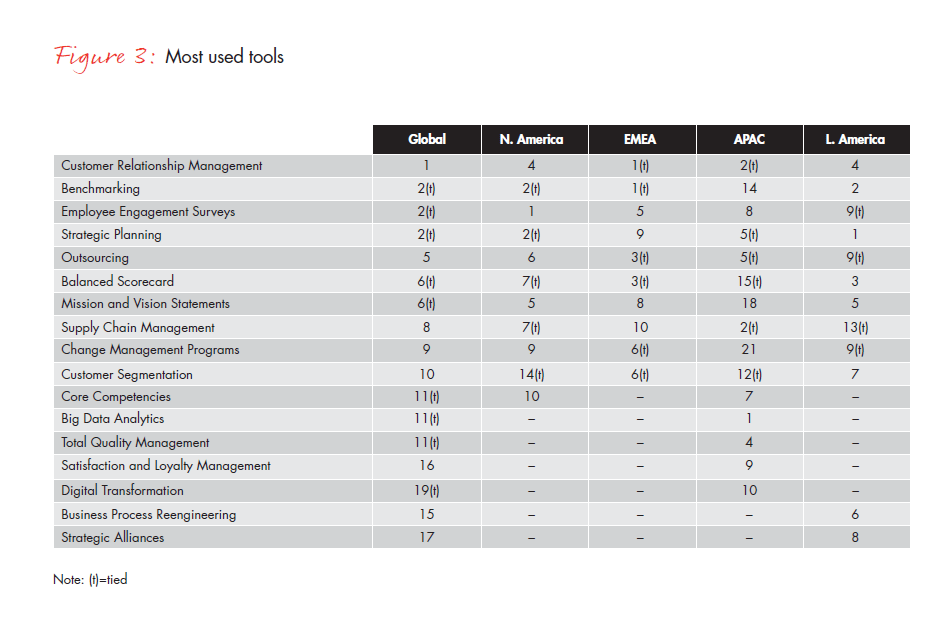
As always, tool preferences and satisfaction varied significantly from region to region (see Figure 4). But this year’s findings highlight a distinct split between North American companies, which strongly prefer traditional tools, and Chinese and Indian companies, which reported greater use of new-school tools like Disruptive Innovation Labs.
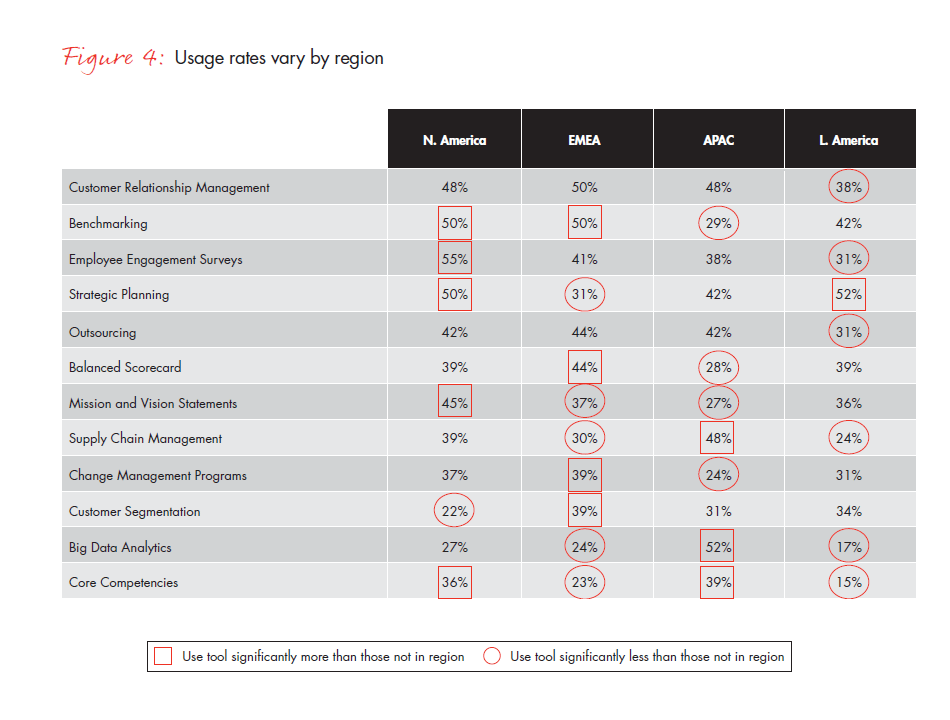

Trend 1: Seeking growth and accelerating innovation in a changing business climate
Global economic growth increased marginally to 2.6% in 2014, whetting managers’ appetites for more. For the third survey in a row, executives ranked revenue growth their top priority in 2015, followed by increased profitability and cost cutting. They cited revenue growth as their main goal twice as often as other priorities like cost cutting or increased profitability.
Reflecting the various stages of economic recovery underway around the world, companies in China, India and North America were the most upbeat. When asked if it felt like economic conditions were improving in their industry, 80% of executives in China and India agreed, along with 61% in North America (see Figure 5). By contrast, in Europe, where many economies are still sputtering, the rate fell sharply to 44%. And in Latin America, where growth is tepid and decelerating, only 31% said economic conditions were improving.
Industries also are recovering at different speeds. Executives in pharmaceuticals and biotech, construction and real estate, financial services, and manufacturing industries were the most confident, with 60% or more convinced that economic conditions are improving. Utilities and energy companies, consumer products, and food and beverage industries were the least optimistic, with 44% or less agreeing.


Despite an upbeat focus on growth, the 2015 survey detected a strong underlying concern about costs and complexity. Overall, 52% of executives surveyed plan to focus more on revenue growth than cost cutting over the next three years—down from 57% in 2013. Regional differences are strong, with 72% of Chinese and Indian firms saying they would put revenue growth first compared with 49% of North American companies.
Few executives are “extremely satisfied” with their organization’s performance on any company metric, including financial results, competitive positioning, customer equity, long-term performance capabilities and organizational integration—a result that tracked with 2013 findings.
Organizational integration ranked lowest, a result that could be linked to executives’ concern about excessive complexity. Nearly 6 out of 10 executives said that they favor long-term results over short-term earnings. Where will companies invest to unlock growth and profits? Four big themes emerged from the survey: Innovation, information technology, reducing costs and complexity, and understanding customers. Mergers and acquisitions are another key investment trend. Already on the rebound worldwide in 2014, they are likely to rise further, according to the survey, a finding consistent with past Management Tools & Trends surveys reflecting similar increases in focus and investment during economic expansions. The 2015 uptick is likely to be particularly strong in Asia. Globally, 57% of executives said they expect effective mergers and acquisitions to be critical to success in their industry, with 74% of Chinese and Indian executives agreeing.
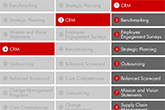
Top 10 tools through the years
This interactive chart shows the most popular tools cited by executives in the latest survey and how they compare to the most widely used tools of past years. View
In our survey, M&A usage showed a slight rise in 2014 after steadily declining usage during the 2006−2012 economic downturn, but the relatively small jump may indicate that the appetite for deal making might be running ahead of actual transactions.
The urge to innovate
In boardrooms around the world, innovation is top of the agenda, as transformative technologies move from lab to market, revolutionizing business models, industries and markets. The vast majority of executives (74%) said that innovation is more important than cost reduction for long-term success. A key challenge for any company is the sheer volume and breadth of transformative technologies (such as genomics, nanotechnology, robotics, advanced materials, industry 4.0 and exponential technologies) poised to shake up the status quo. Executives may view innovation as a strategic ace for coping with those forces, allowing them to steer transformation instead of being crushed by it.
Based on responses to the survey, companies in China, India and Europe appear to be placing greater emphasis on innovation and long-term growth capabilities, substantially outpacing North American companies, likely for different reasons. Eighty-four percent of executives in China and India and 83% in Europe said innovation is more important than cost reduction. China and India may be seeking to wield innovation to leapfrog established global market leaders. These two emerging market countries were the highest users of Disruptive Innovation Labs, a new tool that has low usage (8%) but ranks high in satisfaction (fourth overall). European firms, by contrast, are likely turning to innovation to power growth in a stagnant market and renew their competitive edge.
Companies may also be turning to innovation in response to declining customer loyalty. Executives said customer loyalty/experience was their No. 5 priority in 2015, behind revenue growth, cost cutting, increased profitability, and innovation/new products. Of course, developing innovative products and services is one way companies can differentiate themselves from the competition and keep customers coming back. Another tool related to improving customer loyalty, Customer Segmentation, ranked 10th in usage and third in satisfaction in 2014. European companies were the biggest users of Customer Segmentation.
The urge for a more sustainable economy also may be spurring investment in innovation. Governments, companies and consumers increasingly are embracing sustainable products and processes. Globally, 59% of executives said sustainability initiatives are improving their growth and profits. In particular, midsize companies concurred, with 71% of executives seeing growth opportunities linked to sustainability initiatives. Regionally, China and India had the strongest response, with 85% agreeing, compared with 54% in North America and 46% in Latin America.
Trend 2: Cost and excessive complexity are a worrying hindrance to growth
Two key obstacles to growth and profits loomed large in the 2015 survey: an insidious rise in costs and excessive complexity. Sixty percent of executives said excessive complexity is raising their costs and hindering growth. What’s gone wrong? Globalization has given rise to exceedingly complicated corporate configurations plagued by excessive layers of management, fuzzy decision making, matrix structures and an exponential increase in communications—all of which undercut growth and profits. And there is no quick or simple antidote.
At least half of the executives surveyed seem to be adapting to current challenges by trying new techniques. But rooting out complex structures and processes is no small feat. Making a permanent improvement means transforming an organization’s culture. And at the core of the process is understanding how complexity drives up costs and impedes a company’s ability to innovate.
Data from the Management Tools & Trends surveys show that companies have experimented over the years with a number of tools, such as Business Process Reengineering, to tackle excessive complexity but that they are still struggling to find one that really works. According to a different Bain survey of nearly 300 companies, 40% of those seeking to cut costs by 10% in 2008−09 failed. And even when such programs succeed, costs notoriously tend to creep upward over time. New tools designed to help reduce complexity, such as Decision Rights, first introduced in 2008, ranked high in satisfaction in 2014 (eighth out of 25), and many (44%) expect to use the tool in 2015. Others, including Change Management Programs, got lower-than-average global satisfaction marks. Complexity Reduction, introduced in 2012, looks poised to do better—it ranked No. 2 in projected increase in use for 2015—though it was below average in both usage and satisfaction in 2014.
As companies battle with complexity, Zero-based Budgeting may be another tool poised to rise in usage: A more radical approach much under discussion in boardrooms, it starts with reenvisioning the business from top to bottom. By starting with a blank sheet of paper, Zero-based Budgeting helps managers look beyond their existing organization—particularly those with complex structures following mergers or acquisitions—and design an ideal structure based on strategic goals. Zero-based Budgeting has relatively low usage and satisfaction, but 47% of executives said they plan to use it in 2015, with particularly strong consensus (80%) in China and India and among midsize companies (60%).
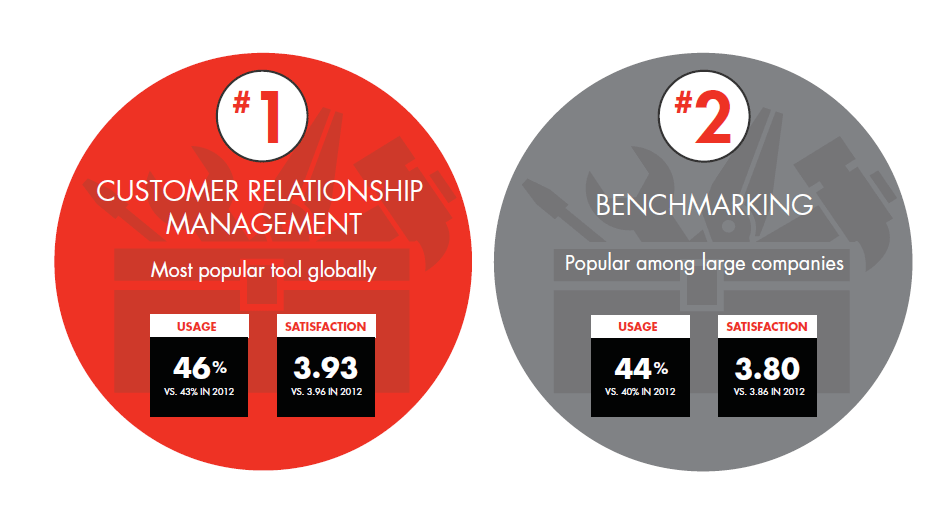
Trend 3: Investing in the digital transformation trend to fuel growth and innovation, master complexity, and confront risks
Digital technologies have been transforming the global economy for decades, but the pace of change is quickening. Innovative new products and services enabled by IT will create tectonic shifts in industries, growth opportunities, risks and disjunctures. That may be one reason why executives are determined to improve their digital agility. Globally, 64% of executives said that over the next three years, spending on IT must increase as a percentage of sales. Most of the respondents who shared this view were from emerging countries, especially China and India, where 83% said spending on IT would rise.
Companies may increase investment in IT to achieve a wide array of goals, from better supply chain management to increasing customer loyalty. They could also identify new markets or improve data security in an era of growing risks and volatility. More than half of those surveyed, for example, said they are using advanced analytics to transform their marketing strategies, with 65% of midsize companies concurring. Forty-two percent of executives said their IT systems are constraining profitable growth, down slightly from 49% in 2012. Firms in China and India are most likely to say that advanced analytics are transforming their marketing strategy (83% agree), compared with North America (47%), Europe (45%) and Latin America (38%).
The ranking of the Big Data Analytics tool in 2015 underscores the management trend. The tool helps companies glean valuable insights from massive quantities of data that can fuel growth. Introduced to the survey in 2012, it ranked first in satisfaction in 2014 and 11th in usage.
The industries moving quickest to harness advanced analytics are healthcare, financial services, pharmaceuticals and biotech, and technology and telecommunications. Companies that are successful in applying advanced analytics utilize it to automate a number of carefully selected decisions so that they are done better and faster, Bain research shows. Thirty percent of companies were extremely satisfied with the Big Data Analytics tool, while only 5% were dissatisfied. Midsize companies were the biggest users of the tool (38%) and the most satisfied with it. But some industries clearly haven’t figured out how to wield it to their advantage. Executives in chemicals and metals and consumer products are the least likely to say that advanced analytics had a significant impact on their marketing strategy.
For many companies, particularly smaller players, the era of Big Data poses a daunting resource challenge. Without the skills and capital to tap the potential of the ongoing digital transformation, many may find it increasingly difficult to close the gap with data leaders and benefit from the trend. They will need IT savvy not only to unleash growth but also to respond effectively to the networked digital economy’s challenges and risks, such as cyber attacks.
What percentage of companies are in good shape? Globally, 56% of executives believe they have the technological capabilities required to be a leader in their industry. That figure is high, and some may be overestimating their ability. On the other hand, it’s possible that many companies have invested heavily in technological capabilities but lack other requisites for market leadership, such as management talent.
Indeed, concerns about cyber attacks showed the largest increase among all management trends since our last survey—a trend that may be accelerating the shift toward greater investment in IT. But it’s not clear that companies will spend enough or soundly to protect themselves against a cyber attack. Globally, 55% of executives said they are very concerned about the impact a cyber attack could have on their business. China and India expressed the greatest fear (74%), followed by North America (60%, up sharply from 43% in 2012), Europe (47%) and Latin America (36%).
Bain research shows that attacks are not only becoming larger but they are more complex and targeted on financial gain. And some organizations face advanced persistent threats. In February, a sophisticated malware called Carbanak hit 100 financial institutions in 30 countries generating $1 billion in losses—the biggest financial loss to cybercrime ever. Intel Security Group’s security division McAfee estimates US losses from cyber attacks at $100 billion a year and worldwide losses at 0.5% to 1.0% of global GDP.
The industries most worried about the threat are healthcare (70%) financial services (67%), and tech and telecommunications (62%). This anxiety is likely to have risen since the November 2014 cyber attack on Sony Pictures Entertainment by North Korea.
Executives at midsize companies were the most concerned (61%) about an attack, followed by large companies (59%) and smaller companies (45%).
Why are companies so ill-equipped to deal with the growing threat of cyber attacks? In our experience, companies often suffer a disconnect between their risk management efforts and the development of cybersecurity capabilities. We also see inconsistency in the way companies approach security planning, operations and funding.
Together, these mistakes create gaps in strategy and operations that leave organizations vulnerable. Leading organizations take a more strategic rather than operational approach to security.

Trend 4: Understanding customers
Another trend linked to growth and the digital transformation is the desire to better understand customers. Leading companies know that improving customer loyalty can help raise revenue and profits. The desire cuts across industries, as retailers, bankers, insurers, manufacturers and utilities search for ways to better understand their customers’ desires—and prevent them from defecting to rivals. In this year’s survey, 62% of executives expressed concern that customers are less loyal to brands than they used to be, and 46% said insufficient consumer insight is hurting their performance.
Satisfaction and Loyalty Management tools can help by tracking customer views and satisfaction and diagnosing root causes of defection. So it’s not surprising that the 2015 survey ranked Customer Relationship Management the top utilized tool for the second time in a row. Employee Engagement Surveys meanwhile ranked No. 2 in use (tied with Benchmarking and Strategic Planning) among all 25 tools, which may reflect increasing evidence of a link between engaged employees and customer loyalty.
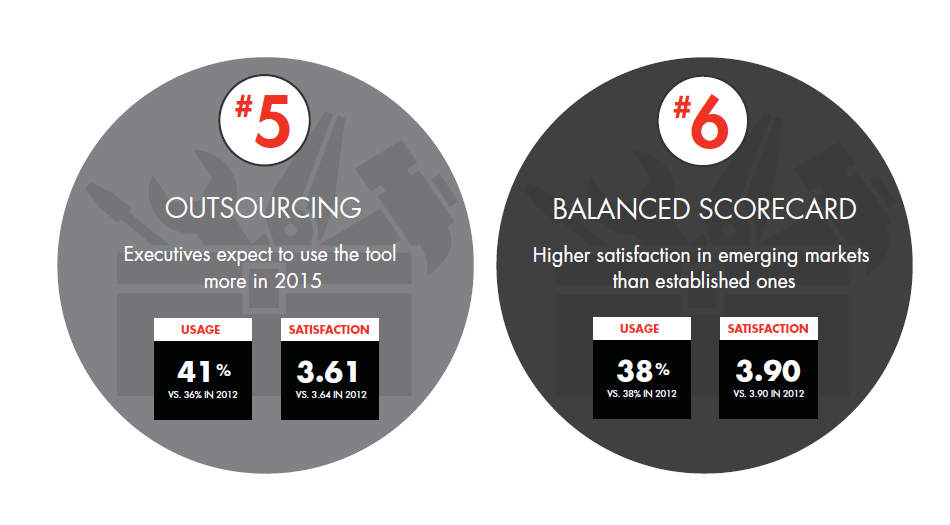
Tool use and satisfaction: Old school vs. new school
Each survey highlights regional differences in tool use and satisfaction. An interesting pattern that emerged from the 2015 survey was a clear split between regions preferring traditional tools and those going for newer tools linked to the digital transformation trend. Such differences may result from varying views on this year’s key trends—namely, growth and innovation, cost and complexity, investment in the digital transformation, and better understanding customers.
Established market firms in North America and Europe are heavier users of more traditional tools such as Benchmarking, Employee Engagement Surveys and Change Management Programs. By contrast, Chinese and Indian companies strongly prefer newer and innovation-linked tools such as Big Data Analytics, Digital Transformation, Disruptive Innovation Labs and Complexity Reduction— perhaps viewing these tools as a way to catapult themselves into global markets as fast followers.
Are two distinct camps emerging—an old school and a new school of tool users? It’s too soon to say. One factor that might play a role in China’s and India’s embrace of digital tools is their greater focus on innovation. As mentioned earlier, 84% of Chinese and Indian executives ranked innovation as more important than cost reduction to long-term success compared with only 63% of North American companies. Chinese and Indian companies seeking to challenge established Western giants in global markets might see innovation as their best strategy and tools such as Disruptive Innovation Labs as a way to unleash more of it.

Interestingly, China and India are using a lot of old tools as well—perhaps an effort to leave no stone unturned as they challenge entrenched market leaders. China and India lead the rest of the world in using Core Competencies (39%), Supply Chain Management (48%), Total Quality Management (47%) and Price Optimization Models (28%), and they matched North America in the use of Outsourcing (both regions at 42%).
Latin American companies show more of a preference than other regions for some of the old-school tools, including Strategic Planning, Strategic Alliances and Business Process Reengineering.
Perhaps the most striking regional finding: North American executives were significantly less satisfied with the majority of tools—old and new—while Chinese and Indian executives were significantly more satisfied with them (see Figure 6). As mentioned above, Chinese and Indian firms expressed far more commitment to innovation than their North American counterparts and were the most confident about their “ability to adapt as a significant competitive advantage” (88%) compared with North America (68%) and Europe (75%). Chinese and Indian executives also were more determined to increase investment in IT (83%) compared with North America (58%), Europe (56%) and Latin America (65%).
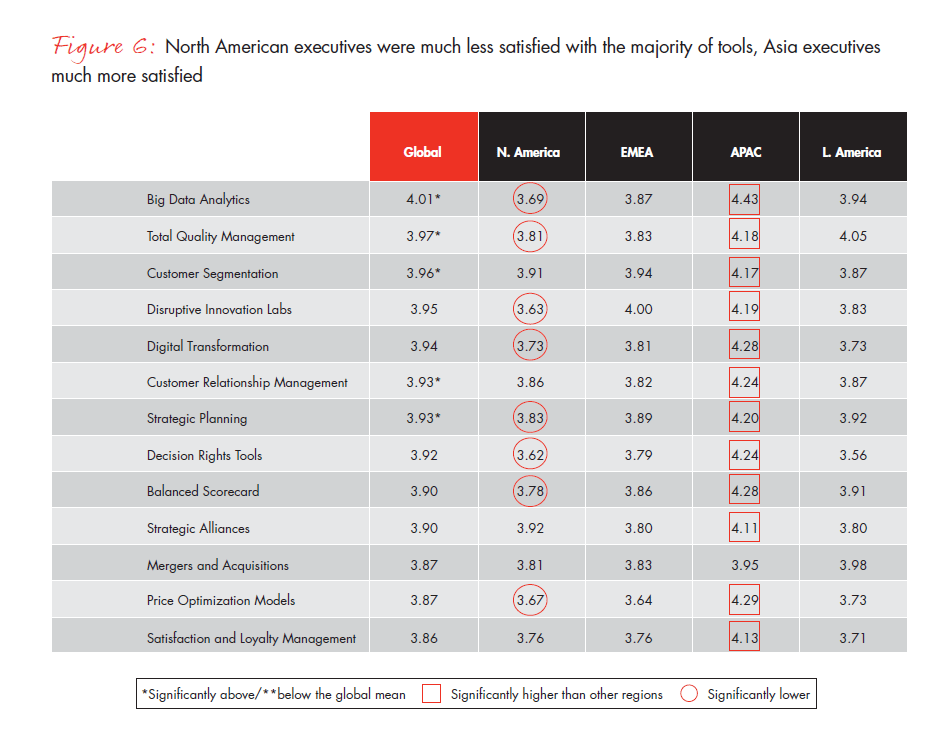
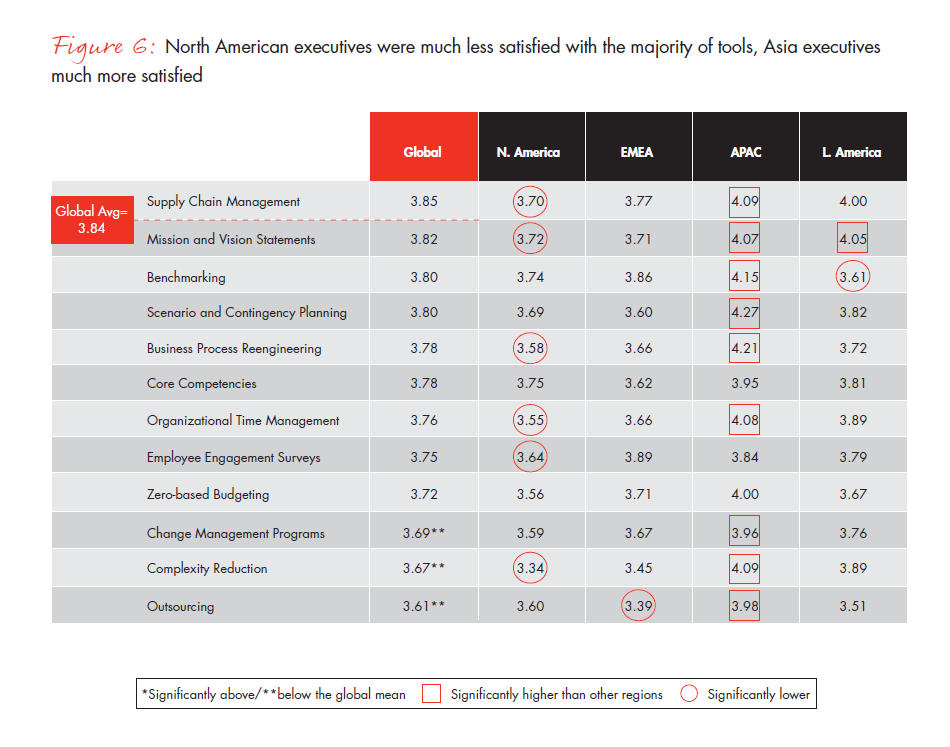
Extrapolating from those results, the greater satisfaction of Chinese and Indian executives with all tools may simply reflect their determination to leapfrog global rivals and their belief that such tools are helping them. On the other hand, it may also reflect excessive optimism about the impact of management tools based on fewer years of experience with them.
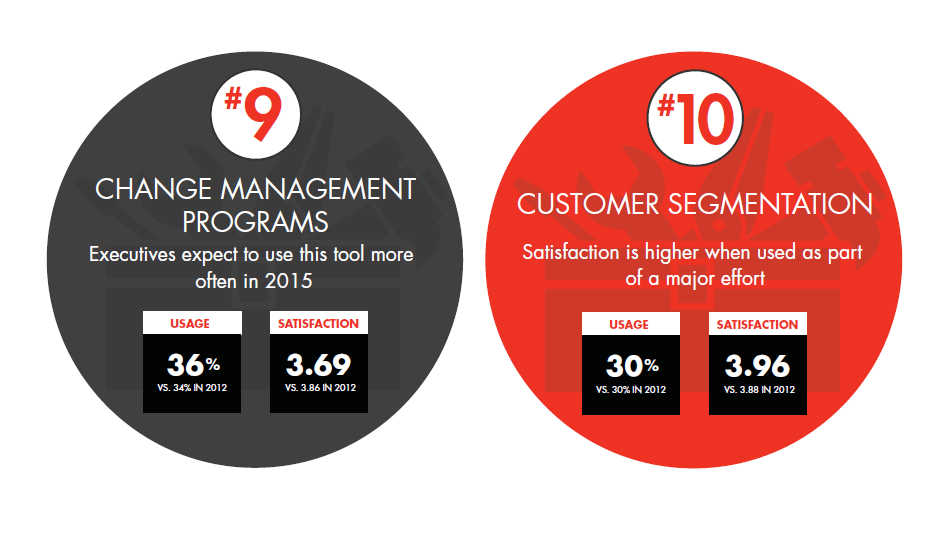
Summing up
The six most popular tools of 2012 remained in the top six for 2014, with Customer Relationship Management the No. 1, followed by Benchmarking, Employee Engagement Surveys, Strategic Planning, Outsourcing and Balanced Scorecard (see Figure 7). Core Competencies was the only tool to drop out of the top 10 from 2012.
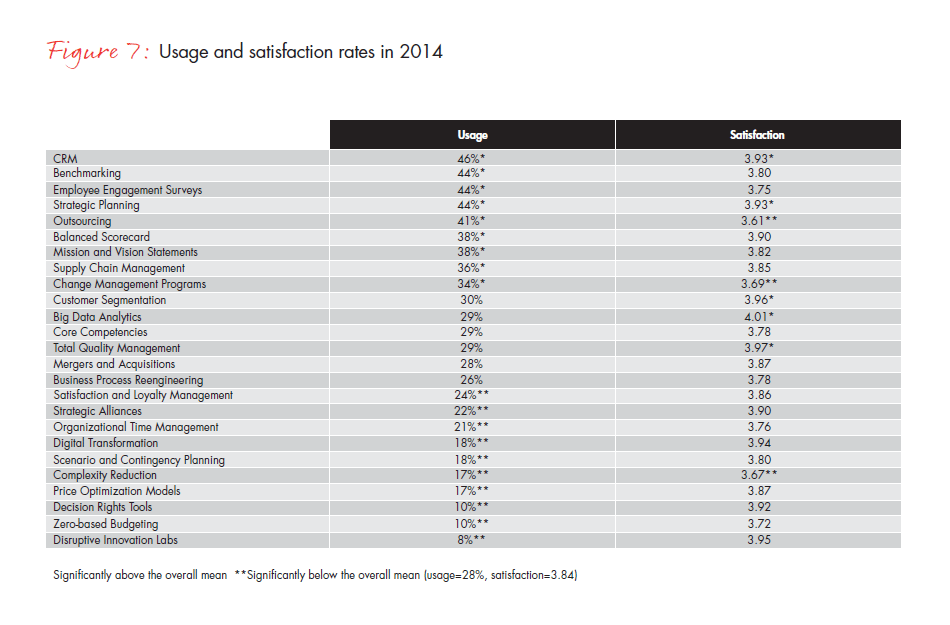
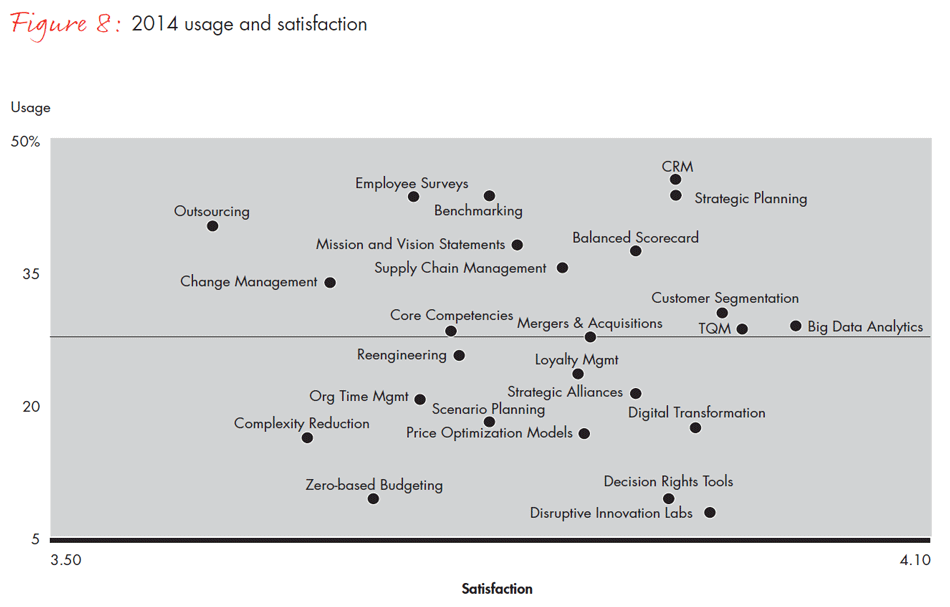
Comparing the top 10 tools over a 10-year period, Strategic Planning, Benchmarking, Outsourcing, and Mission and Vision Statements consistently remain in the top 10.
It’s important for companies to understand that not every tool is right for every situation. Based on our experience tracking tool use, when satisfaction is high but usage is low, usage tends to grow. One example is Big Data Analytics, which looks poised to increase in use (see Figure 9). When usage is high and satisfaction is low, usage tends to drop, as is the case of Change Management Programs—that is, unless the tool improves, as was the case with Customer Relationship Management.

The tools with the greatest satisfaction spread, showing more executives satisfied than not satisfied, were Total Quality Management, Big Data Analytics, Decision Rights Tools and Digital Transformation. No matter what tools companies prefer, it’s clear that major efforts with tools produce better satisfaction scores than limited efforts, and some tools may not be worth using on a limited basis. For some tools, the difference is enormous: Balanced Scorecard rated third-highest tool when used as part of a major effort, but it tied for 17th when used on a limited basis (see Figure 10).
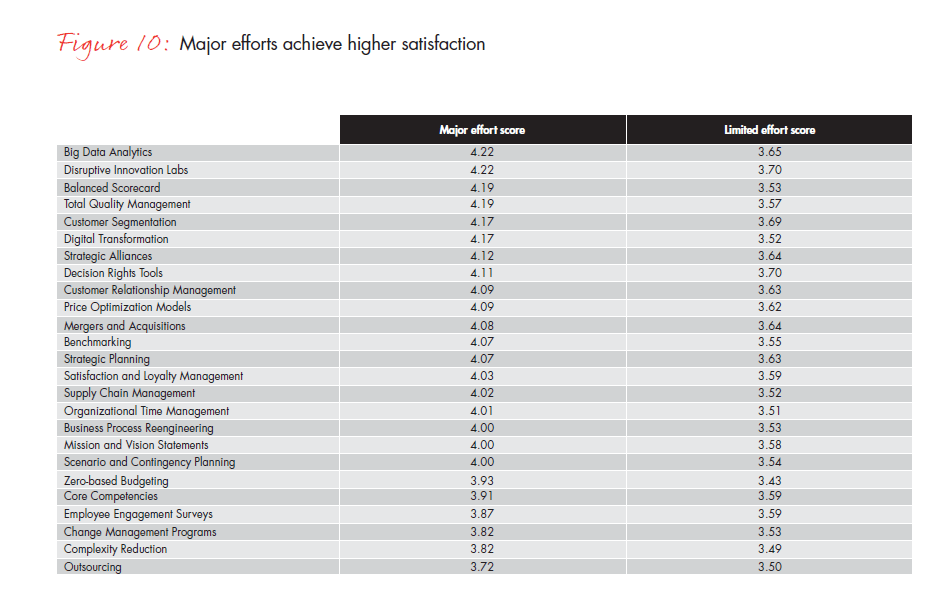
Globally, the trend toward using fewer tools continues. Companies used an average of 7.0 tools in 2014, down slightly from 7.4 in 2012. Tool use peaked in 2002, when companies used an average 16.1 tools. Overall, tool use has declined steadily since 2006, when the average use was 15.3 tools.
The larger the company, the more likely it is to use the vast majority of tools. But tool use increased in midsize companies.
On average, large companies used 8.1 tools in 2014 compared with midsize firms’ usage of 7.6 tools (up from 6.8 in 2012) and smaller companies’ usage of 5.3 tools.
Regional variation in tool use is significant. China and India used the highest average number of tools in 2014 (8.0) compared with North America (7.2), Europe (6.6) and Latin America (6.2). Industries with the heaviest tool use are transportation and tourism, manufacturing, and technology and telecommunications.
The tools projected to have the biggest gain in usage in 2015 are Scenario and Contingency Planning, Complexity Reduction, and Organizational Time Management.
As companies seek to grow and innovate in an era of rapid technological change, we offer the following four suggestions based on our research to help managers get the most out of the tools they choose.
- Get the facts: Every tool has strengths and weaknesses. And tools’ usefulness can change over time. To succeed, companies need to understand the full effects of each tool and then combine the right ones in the right ways at the right times. Peruse the research and talk to other tool users. Don’t naively accept hyperbole and simplistic solutions.
- Champion enduring strategies, not fleeting fads: Line managers and tool experts don’t always have perfectly aligned agendas. Tool experts may have an engaging perspective, but managers must manage. Companies should champion realistic strategic directions and view tools as an aide, not a panacea.
- Choose the best tools for the job: Managers should take a rational approach to selecting and implementing tools. A tool will only improve results to the extent that it identifies customers’ unmet needs, builds distinctive capabilities, exploits competitor vulnerabilities and develops breakthrough strategies.
- Adapt tools to your business system—not vice versa. Our research shows, for example, that major efforts achieve significantly better satisfaction scores than limited ones. If management can only engage in a limited effort, it may be best to avoid using some tools. It’s also important to keep in mind that satisfaction scores for the same tool can vary widely depending on company size and region.
Executives are determined to benefit from an expanding economy. But as they focus on growth in an improving climate, they risk becoming overconfident. Disruptive technologies already have begun transforming industries and markets, requiring executives to pivot faster than in the past. The companies that do manage to pull away and build leadership positions will take a measured approach and invest in the right tools for growth.
Darrell Rigby, a partner with Bain & Company and leader of Bain’s Global Retail and Global Innovation practices, has conducted Bain’s Management Tools & Trends survey since 1993. Barbara Bilodeau is the director of Bain’s Advanced Analytics Group.
A history of Bain’s Management Tools & Trends survey
Starting in 1993, Bain & Company has surveyed executives around the world about the management tools they use and how effectively those tools have performed. The objective: to provide managers with information they need to identify and integrate tools that will improve bottom-line results, and to understand how global executives view their strategic challenges and priorities.
We focus on 25 tools, honing the list each year. To be included in our survey, the tools need to be relevant to senior management, topical and measurable. By tracking the tools companies are using, under what circumstances and how satisfied managers are with the results, we’ve been able to help them make better choices in selecting, implementing and integrating the tools to improve their performance.
With this, our 15th survey, we now have a database of more than 13,000 respondents from more than 70 countries in North America, Europe, Asia, Africa, the Middle East and Latin America, and we can systematically trace the effectiveness of management tools over the years. As part of our survey, we also ask executives for their opinions on a range of important business issues. As a result, we are able to track and report on changing management priorities.
For a full definition of the 25 tools, along with a bibliographical guide to resources on each one, please see the Bain & Company booklet Management Tools 2015: An Executive’s Guide on www.bain.com.